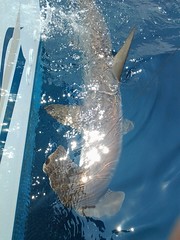
Maryland manages 41 species of coastal sharks, including
spiny dogfish. Some sharks are found
strictly in coastal waters, and others, like the bull shark, are also found in the main stem and some rivers of the Chesapeake Bay. Shark management is a joint effort of the State of Maryland, Atlantic States Marine Fisheries Commission, National Oceanic and Atmospheric Administration, and the International Commission for the Conservation of Atlantic Tunas.
Management:
The Atlantic States Marine Fisheries Commission and State of Maryland manage coastal shark fisheries in state waters (out to three miles) while the National Oceanic and Atmospheric Administration manages shark fisheries in federal waters (3-200 miles offshore). The National Oceanic and Atmospheric Administration implemented the Consolidated Highly Migratory Species Fisheries Management Plan which includes sharks of the Atlantic Ocean to help replenish and protect shark species.
Subsequently, the Atlantic States Marine Fisheries Commission adopted an Interstate Fishery Management Plan for Atlantic Coastal Sharks. The Atlantic States Marine Fisheries Commission Fisheries Management Plan manages forty species of sharks with a goal of being as consistent as possible with the federal Consolidated Highly Migratory Species Fisheries Management Plan (NOAA 2006). Additionally, spiny dogfish are also managed at the State and federal level under separate management plans. The International Commission for the Conservation of Atlantic Tunas has prioritized the biological study and assessment of the major sharks of the epipelagic system as these species are more susceptible to being caught as by-catch by oceanic fleets targeting tuna and tuna-like species. Among these shark species there are some of special prevalence and with an extensive geographical distribution within the oceanic-epipelagic ecosystem, such as the blue shark and shortfin mako shark, and others with less or even limited prevalence, such as portbeagle, hammerhead sharks, thresher sharks, and white sharks.
State shark regulations are available in the
Annotated Code of Maryland (COMAR). Some municipalities also have relevant ordinances. Federal shark permit and regulatory information are available from the National Oceanic and Atmospheric Administration in
compliance guides.
More information about sharks and other highly migratory species
is available in the Maryland Guide to Fishing and Crabbing.
